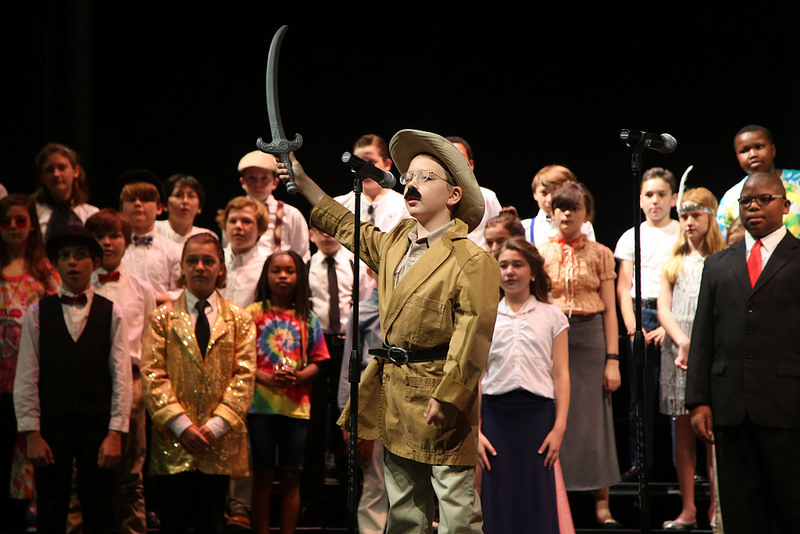Leading With Others: Performing arts create venue for collaboration
Drawing from many cultures and traditions, the performing arts have developed their own vocabulary, from “prompt corner” and “stand partner” to “tonality” and “blocking.” Performing arts students master the terminology as they master their crafts.
When it comes to the language of Lead From Here, they have found the citizen leadership framework speaks to the core values of their discipline: accountability, motivation, cultural inclusivity, adaptability, empathy, self-awareness, collaboration.
What better place to learn these competencies than in the arts?
“WE HELP EACH OTHER GROW”
Zach Skubic ’19, who plays trombone in the Upper School band, agreed, noting that the performing arts provide the perfect blend of leading self and leading with others.
“Whether you’re playing a challenging solo by yourself or an easy part with a 72-piece ensemble,” he said, “you have to remain aware of your tone, your place in the music and your dynamics as well as what is happening around you and how others play their instruments.”
Honors Choral Ensemble member Bek Campbell ’19 added,
“I not only have to lead with my experience as a senior choir member but also listen to my fellow members and be open to critique when necessary. We help each other grow as singers.”
Faculty also incorporate student leadership into their class structures. Section leaders like Bek, for example, make notations on scores, provide feedback to polish the group’s sound and even lead rehearsals with director Cameron Bolin. Ravenscroft’s Band Council organizes student orientation, decorates for concerts and manages the department’s inventory of instruments.
Strings director Pamela Kelly provides opportunities for leadership in Middle School strings, modifying the traditionally competitive “seating” structure to allow students to rotate through chair positions.
“If I want a strong crop of ninth-graders in the orchestra, it’s in my best interest to give all Middle School students the opportunity to lead,” she explained. “It’s a different feeling when you’re sitting behind somebody than when you’re up front. It’s important to experience both.”
“POSITIVE ENSEMBLE ETHIC”
Mentorship is another role familiar to students in the performing arts, where upperclassmen frequently rehearse and perform with younger students. The faculty leaders in Fine Arts team freshmen with seniors who help them acclimate to Upper School. Kelly’s Honors Strings students regularly work with the Lower School orchestra.
In the theater department, “we are always collaborating with younger Ravens so they can learn the ropes and eventually be the student leaders,” lead stage manager Kemmia Ghodrat ’19 said.
In fact, collaboration may be the Lead From Here competency that feels most essential to Ravenscroft’s performing arts programs.
“Both collaboration and competition are always present in the theater,” drama director Jason Sharp said. “We strive to create what I call a positive ensemble ethic — a sense of support for one another’s work, safety and growth.”
That emphasis makes an impression. Last fall, concertmaster Melissa Kong ’19 was sick in the weeks preceding the strings concert. Assistant concertmaster Mia Russo ’19 stepped up and prepared for Melissa’s solo. When Melissa returned in time to perform, the two decided to play together, in what Kelly proudly called “a collaborative solo.”
“It ended up working out much better than if one of us had played the solo individually,” Melissa said. “Mia was very supportive and accepting.”
“THE POWER OF STUDENT LEADERSHIP”
Lead From Here has also empowered Ravens in the performing arts outside the classroom, mentoring young talent or teaching underprivileged children. In January, many performing arts students participated in the school’s SPEAK program, exploring diversity and inclusivity through performances and workshops. Members of an Upper School club, Share the Love and Music, perform regularly at a local nursing home.
“Taking a leadership position in the theater department was a segue to other opportunities outside of school, like the Honors International Thespian Society,” Kemmia said. “I have felt more confident putting myself out there, trying new things and meeting new people.”
For nearly a decade, the Band Council has organized an ambitious fundraiser in support of St. Baldrick’s Foundation. The popular event — at which students, faculty and staff, alumni, families and friends shave off or cut their hair in exchange for pledges — has raised nearly $600,000 for childhood cancer research.
“The work students put into St. Baldrick’s events speaks to the power of student leadership and the impact Lead From Here has on our local and even national and global communities,” said Zach, who, as president of Band Council, led this year’s event. “It might not have much to do with playing an instrument per se, but it serves as a perfect example of how a leadership framework like Lead From Here can help students change our world.”





















